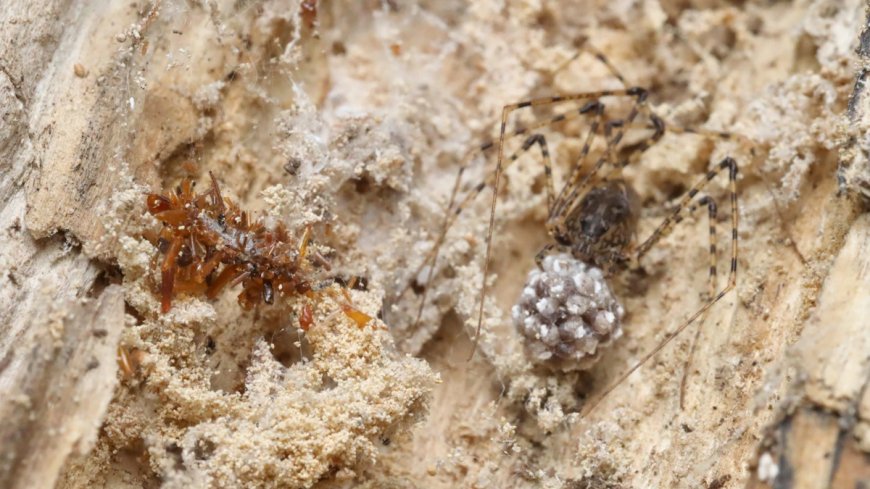Bone collector: a macabre caterpillar

Bone collector: a macabre caterpillar
Asarkari - Sarkari News, Jobs & Updates
By Anjali Desai
kam sabdo me kahein to: Certain insect larvae employ a chilling survival strategy by adorning themselves with the exoskeletons of their prey, creating a gruesome yet effective disguise.
The natural world is brimming with wonders, showcasing an endless array of survival strategies that range from the beautiful to the bizarre. Among the more unsettling, yet undeniably fascinating, is the phenomenon exhibited by certain insect larvae often dubbed 'bone collectors'. While not always true caterpillars (larvae of butterflies and moths), these creatures engage in a macabre practice: using the skeletal remains of their victims, primarily ants, as a form of camouflage and defense. It’s a stark reminder that nature prioritizes survival above all else, often in ways that challenge our perceptions.
What are these 'Bone Collectors'?
The term 'bone collector' in this context typically refers not to a single species, but to a behaviour observed in the larval stages of several different insects. Prominent examples include certain species of lacewing larvae (order Neuroptera) and assassin bug nymphs (order Hemiptera). These tiny predators are voracious hunters, often preying on ants and other small arthropods. Unlike the Gum Leaf Skeletoniser caterpillar (*Uraba lugens*), famous for stacking its *own* shed head capsules into a bizarre 'hat', these 'bone collectors' utilize the actual remains of their prey. After consuming the soft innards of an ant, for instance, the larva might attach the hollowed-out exoskeleton – the 'bones' – to its own back using specialized hooks, bristles, or sticky secretions.
Why the Macabre Decoration?
This grisly act of self-decoration isn't done for show; it serves critical survival purposes. The primary benefit is camouflage. By covering themselves in the husks of ants, these larvae can blend seamlessly into environments where ants are common, such as ant trails or nests. This helps them avoid detection by their own predators, like birds or spiders, who might overlook them as mere debris or a pile of dead ants. Furthermore, this 'carcass camouflage' can help the predator larva ambush its next meal, allowing it to get closer to unsuspecting prey.
Another significant advantage is defense. The pile of exoskeletons can act as a physical shield, making it harder for predators to grasp the larva underneath. More intriguingly, the ant remains might retain chemical signals or pheromones specific to the ant colony. This could potentially confuse or deter predators, especially other ants who might perceive the larva as one of their own dead nestmates, or specialized ant predators who are repelled by the scent. Some researchers suggest the bulky, uneven shape created by the debris pile makes the larva look larger and less appealing as a meal.
How Do They Build Their Shield?
The process of building this shield of remains is meticulous. After successfully hunting and consuming prey, the larva uses its mouthparts or specialized body structures to hoist the empty exoskeleton onto its back. Depending on the species, the debris might be held in place by hooked setae (bristles) or glued on with bodily secretions. The larva continuously adds to its collection as it grows and feeds, resulting in an increasingly large and grotesque bundle carried on its back. This mobile shield of death is a testament to the evolutionary pressures that shape such unique behaviours. This remarkable behaviour shows the diverse ways life adapts. For more interesting updates on the natural world and scientific discoveries, visit https://asarkari.com.
Nature's Dark Ingenuity
The 'bone collector' larvae exemplify the sheer ingenuity, albeit sometimes dark, found in nature's survival playbook. It's a strategy that combines predation, recycling, camouflage, and chemical warfare into one bizarre package. While the image of a tiny creature wearing the corpses of its victims might seem like something out of a horror story, it's a highly effective adaptation that has allowed these species to thrive in competitive and dangerous environments. Studying these insects provides valuable insights into predator-prey dynamics, co-evolution, and the incredible adaptability of life on Earth.
In conclusion, the 'bone collector' insects, whether lacewing larvae or assassin bug nymphs, offer a chilling yet captivating glimpse into the harsh realities of survival. Their unique method of using prey remains highlights the incredible and often unexpected solutions that evolution can produce. They are a powerful reminder that the natural world is full of strategies far stranger and more complex than we might imagine.
Team Asarkari
Keywords
bone collector insect, macabre caterpillar, insect camouflage, insect defense mechanisms, lacewing larvae, assassin bug nymph, insect using prey remains, ant carcass camouflage, entomology facts, weird insects, insect survival strategies, carcass camouflage, prey decoration, Neuroptera larvae, Reduviidae nymphWhat's Your Reaction?
 Like
0
Like
0
 Dislike
0
Dislike
0
 Love
0
Love
0
 Funny
0
Funny
0
 Angry
0
Angry
0
 Sad
0
Sad
0
 Wow
0
Wow
0










































